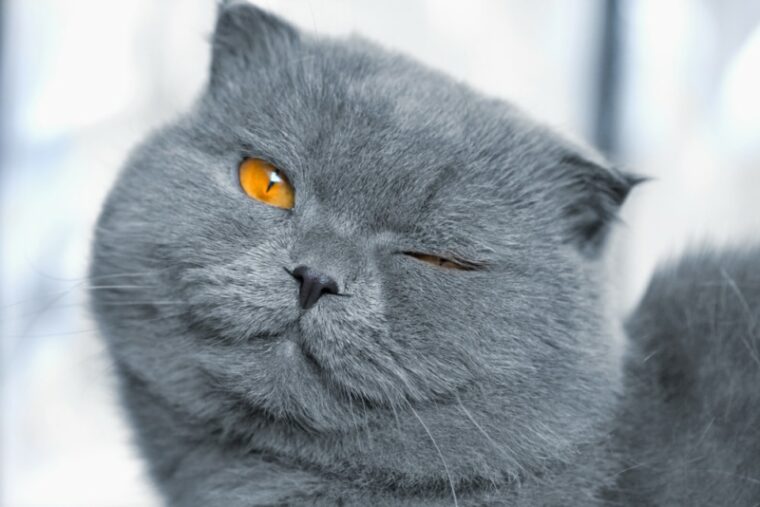
Click to Skip Ahead
Humans wink at each other to communicate specific messages, usually concerning flirting or romantic interest. Because of this, you may be charmed by the sight of your cat seeming to wink at you. However, not every wink from a cat is a good sign.
For cats, winking can serve as a communication tool, but it may also indicate something is wrong with your kitty’s eyes. In this article, we’ll cover the positive and negative reasons why your cat is winking, including what to do if you suspect your cat’s eye movement indicates a medical problem. We’ll also talk about other ways your cat uses their eyes to communicate.
When Animals Say I Love You: The Slow Blink and Wink
The first and most adorable reason your cat might be winking is to communicate trust and affection. For cats, closing their eyes when they’re around another animal or human requires a strong level of trust. Your cat must believe they are secure enough to eliminate one of the senses that helps keep them safe.
Slow blinking is the specific eye movement that cats use to tell us that we are loved and trusted. They do this by holding their eyes partly closed and blinking or winking with one or both. You may even be able to coax your cat into performing this behavior by doing it yourself.
A study from England published in 2020 strongly suggests that cats interpret humans performing the slow blink just as they do other kitties. Cat owners who copy this communication may improve their bond with their pets.
When Cat Winking Goes Wrong
Like a human wink, harmless or positive cat winking typically involves a quick eye movement. If your cat’s face appears stuck in a permanent or longer-lasting wink, it could be an indication that the eye is injured or infected. The length of time your cat is “winking” is one way for you to determine if it is a sign of love or something more serious.
Cats may squint or hold their eye closed as a sign of pain or irritation. Multiple eye conditions could cause your cat to “wink,” including the following:
Besides the length of time your cat is winking, you may notice the following signs if your cat has a medical problem with their eyes:
If you notice any of these signs, see a veterinarian as soon as possible. Most cat eye issues are considered emergencies that must be treated quickly for the best outcome. Your vet may perform tests to diagnose your cat, including measuring their eye pressure, checking the tear production, and placing a colored stain in the eyes to look for scratches or injuries.
Your cat may need eye medications or pain control, depending on what your vet discovers. In some cases, your vet may recommend a referral to a veterinary eye specialist. Following the recommended treatment plan carefully is essential to avoid complications or more serious eye damage.

What Else Do Cats Tell Us with Their Eyes?
Cats rely heavily on body language and scent to communicate among themselves and sometimes with humans. Unfortunately, we humans don’t always get the message. Here are some other eye movements cats use and what they’re trying to say.
Large Pupils
If your cat’s pupils increase in size, it could indicate several things, including fear, aggression, or that your kitty is feeling playful. Look for other body language to help you interpret which emotion your cat is trying to express. For example, are your cat’s ears flat on their head and their tail tucked, puffed, or whipping rapidly?
If they are, your cat may be irritated or frightened. Playful cats may crouch on the ground but leave their tail up and quivering to indicate excitement. You may also spot them wiggling their hips as they prepare to pounce on a toy.
Tiny Pupils
When your cat’s pupils get smaller, it can indicate they are feeling either content or aggressive. Again, look for other clues to help you figure out which it is. For example, is your cat slowly blinking at you with their small pupils? That’s a good sign!
Intense Eye Contact or a Stare Down
When cats are feeling aggressive toward each other, they may try to stare each other down rather than fight. If your cat seems agitated and makes intense eye contact with you or someone else, it shows aggression or anger. For example, you may see this behavior at the vet if your cat strongly objects to their annual checkup.
Conclusion
Cats wink to demonstrate love, affection, and contentment to each other or their owners. A wink that progresses to frequent squinting or holding the eye shut could indicate a medical issue. Look for additional medical signs and body language clues to help you figure out why your cat is winking at you. Don’t delay getting your cat medical help if you suspect the winking is due to a health issue. Eye conditions can be painful and get worse quickly. The faster you can get your cat diagnosed and treated, the better.
Featured Image Credit: 5464316719, Shutterstock







